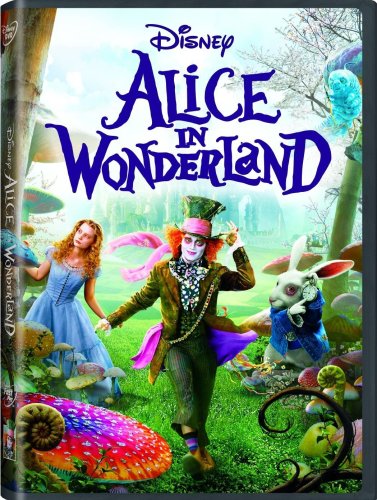All Nonfiction
- Bullying
- Books
- Academic
- Author Interviews
- Celebrity interviews
- College Articles
- College Essays
- Educator of the Year
- Heroes
- Interviews
- Memoir
- Personal Experience
- Sports
- Travel & Culture
All Opinions
- Bullying
- Current Events / Politics
- Discrimination
- Drugs / Alcohol / Smoking
- Entertainment / Celebrities
- Environment
- Love / Relationships
- Movies / Music / TV
- Pop Culture / Trends
- School / College
- Social Issues / Civics
- Spirituality / Religion
- Sports / Hobbies
All Hot Topics
- Bullying
- Community Service
- Environment
- Health
- Letters to the Editor
- Pride & Prejudice
- What Matters
- Back
Summer Guide
- Program Links
- Program Reviews
- Back
College Guide
- College Links
- College Reviews
- College Essays
- College Articles
- Back
Alice In Wonderland
Expectations were exceedingly high when Tim Burton and Johnny Depp first announced that they were teaming up yet again to remake Lewis Carroll’s iconic tale, Alice In Wonderland. Given that Alice is already widely known as one of the trippiest, most characteristic examples of literary nonsense, many assumed that its weirdness would double in the hands of Burton. While the film definitely has its weird and delightfully bizarre moments, overall Alice is a visually stunning yet ultimately hollow and predictably written movie.
Burton’s version is a bit different from both Carroll’s 1865 book and Walt Disney’s take on it back in 1951. For starters, Alice is now almost 20 years old (instead of 7) and delves into Wonderland when confronted with the starch ways of the Victorian society which she lives in. However, the new script is more similar to Carroll’s than Disney’s in that the Chronicles of Narnia-esque storyline follows Alice’s quest to slay the feared Jabberwocky and restore Wonderland (or “Underland”, as it is now called) back to the good White Queen. Making Alice into a hero’s journey rather than solely focusing on Alice’s attempts to return home and the eccentric characters she meets along the way helped to move the story along, but Linda Woolverton’s script was a bit predictable and, most unfortunately, that hallucinatory, whimsical feel so closely associated with Lewis Carrol’s classic just wasn’t present for most of the movie. As we have come to expect from all things Burton, Alice was definitely weird and bizarre, but overall the film seemed to lack a certain sense of playful wonder.
Fortunately, what the film lacks in its storyline is mostly made up for by its visuals. Using the latest CGI technology, Burton and his crew were able to create a new Underland unlike any other. The delightfully deranged characters Burton has created are spectacular – you can tell a lot of meticulous effort was put in by the crew to make each 3D creature come to life – and even those who didn’t receive help from CGI came out freakishly fantastic (namely the Mad Hatter, whose warped look was created chiefly with makeup). Burton also chose to put Alice in 3D, which was pretty unnecessary and mostly just an annoyance to wear the glasses. This was most likely due to the fact that the movie was shot using 2D cameras and 3D effects were added later on, making them less integral to the movie than Avatar’s (which was filmed using bleeding edge-3D cameras) were. Nonetheless, both the landscape and characters in Alice are visually stunning and a testament as to how far CGI technology has come in moviemaking.
Among the most fancifully distorted CGI creations in the film was the evil Red Queen, played by Burton’s spouse, Helena Bonham Carter. As the bratty, easily angered Red Queen, Carter and her overly bulbous head stole the show and had some of the funniest lines throughout the movie. Other than Carter and the film’s title character (played by Mia Wasikowska) the most fun to watch characters in Alice were Tweedle Dee and Tweedle Dum (both played by Matt Lucas) and the elusive Chesire Cat (voiced by Stephen Fry).As for Johnny Depp’s portrayal of the Mad Hatter, Burton’s favorite actor delivered Lewis Carroll’s nonsensical words with ease and was a delight to watch. Anne Hathaway’s performance as the Good White Queen, on the other hand, was just short of unbearable. Hathaway lobbied hard for her part in the film but, judging from her unconvincingly annoying performance, casting should have lobbied just as hard to keep her out.
Despite it’s flaws, Alice In Wonderland is by no means a bad film – at least for viewers going in with no preconceived notions. Those expecting Burton to take Alice to a trippy, new level of psychadellic weirdness and create a new classic version of Alice for the next generation may leave the theater disappointed, so you’re probably better off lowering your expectations. Ultimately, though, it’s the visual landscape that will draw viewers in, as Burton has finally found technology that can keep up with his imagination and used it to create a cleverly designed canvas, just not that clever of a film.
Similar Articles
JOIN THE DISCUSSION
This article has 0 comments.

